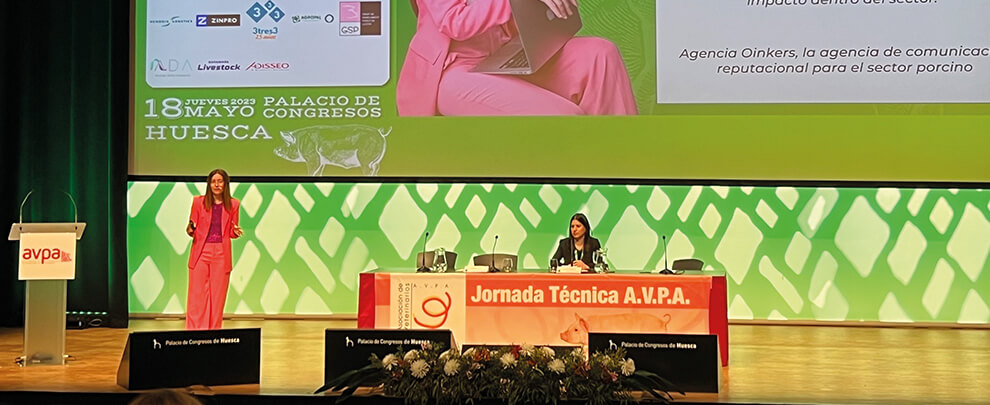Blog
Blog

Communicating the pig farming sector: the big challenge with consumers
10th April 2025 - News
Being a graduated veterinarian and wanting to one day work as a field veterinarian, life took Gemma Ticó down other paths. After working as a technician in a genetics company for some time, she arrived at the newsroom of a communication agency in the sector. She realised that the industry had been communicating amongst themselves for years but did not do so towards society. So, amid the pandemic, she decided to take the leap and start explaining the sector's reality to society and consumers before waiting for others to do so in not such a positive way. We talk to Gemma Ticó, an expert voice in the pork sector's communication field, to analyse how society sees us and the significant challenges in communication.

Gemma Ticó, veterinarian and communicator specializing in the swine sector. Photo: G.T.
What image do you think consumers have of the pork sector?
I feel bad about saying it, but despite what we think, they don't see us or even know that we exist. Many consumers do not think about where a loin steak or ham comes from, so we already have a big problem. And then we have the other issue: when they know us, unfortunately, they usually recognise us because of negative news or programs like the one a few years ago on La Sexta, where the sector seems to be the worst in the world. Of course, if you do not know the industry, the first input you receive is that type of image, then it is expected to have a negative image or fear. In the end, if we went to Google and looked for information as if we didn't know anything about the sector, with some of the news you find, even if I like ham overly much, I want to go vegan and start eating tofu. There are news, although fortunately less and less horrific.
What tools do we have to reverse these two realities?
We have several. I admit that I was the first to make the mistake of going to social networks because it is a tool to reach more people. But of course, then it is true that you realise that social networks are complex if you want to do it well, so I have been working in two areas for a long time: an online part, especially at the level of social networks, which I think are very useful, but which require knowledge, a strategy, having a specific budget and time, and knowing how to manage criticism, etc. And then there is another offline part, which we often forget, but which is frequently as simple as if I am with my friends or in the gym and, suddenly, the subject of the pork sector comes up, explaining what I am doing and what the industry is really like.
You often discuss reputational communication. What is it, and what can companies and farmers do in this area?
We are a sector that is the target of criticism because there are parts that are complex to explain, such as that we "kill" animals, even if it is for consumption. In this idealised world, where talking about death is taboo, is where you have to work on that part of the reputation. We must communicate to reverse some ideas and explain why we do socially frowned upon things that can generate a crisis in the sector. In this sense, we can do two things: prevent and cure. At the level of prevention, what we can do is analyse what risks there are in the sector of having an information crisis due to issues such as the slaughter of animals, their welfare, the use of antibiotics, and environmental issues... and see how to explain it correctly, with our words and arguments. Then, there would be the cure part, when we detect a news item against the sector that we know is untrue. So you have to go to that news, take it and explain it point by point to refute it. Reputational communication works more on prevention because, in the end, you are the one who decides what to communicate and how. This is what in journalism is called fine rain and what, for example, you have been doing for a long time at Rotecna to gradually provide information about the sector's reality. On the other hand, in the restorative part, we talk about having to defend ourselves. When you protect yourself, you start with information that someone else has biased or shared in a specific way, so we have to communicate not as we want but differently to try to deny what someone else has said.
Do you think the sector is doing enough to improve its image?
No, and we have a long way to go. However, I am hopeful that there will come a time when, despite the apparent differences between competing companies, we will put that aside and understand that although we each defend what is ours, our products and our company, we also have a common goal, which is to protect the sector. It would be perfect if we all worked together and generated a communication strategy that would allow all companies and agents in the industry to communicate simultaneously. For example, establishing a plan that tells us that on a specific day, we are all going to talk about well-being, each in their own way, but we are all going to talk about the same topic. This would be very powerful, and we would make a lot of noise. It could be very utopian, but it would be ideal for me, and it's what the sector lacks. Another aspect that I think we should start considering is to teach pigs and our daily work on farms without filters because sometimes it can seem that the fact of being "closed to the letter" for biosecurity is because we want to hide something. I know it is a complex and terrifying issue, but if it were well explained, it would have fewer consequences than we imagine a priori.
Is it a significant cost to invest in communication? Can the return be measured?
Economically, it is complex because, in the end, communication does not have a tangible return, as when we carry out actions to improve production on the farm. This means one more piglet per sow and thousands of euros more per year. We don't have that. Investment depends a little on how far you want to go. For example, there are some companies that I only consult because they have some veterinarians or young farmers who are already used to social networks and how to record videos..., and with a bit of guidance, they start to do something. It isn't easy to assess the economic return, but it brings visibility to the company and the sector, and you see that people tell you how cool what you do and how good it is... That is usually something that is discussed with companies that work in communication. And then there is also the personal satisfaction of telling what we do as a sector.
What do you think will be the significant challenges in communication for the future of the pork sector?
The first is to achieve unity in the sector so that most of us can communicate more or less simultaneously on specific issues to make more noise. Another challenge when communicating with consumers and society is fighting this idealisation or humanisation of animals. For me, there is a great challenge there. The entities opposed to animal production have done a great job; we must recognise it when it comes to humanising pigs and achieving that sensitivity that we can have, for example, with our dogs or cats. We also have to talk about sustainability and the environment because young people are a generation that cares a lot about the planet. And finally, we must improve our communication with doctors and nutritionists so that they stop saying outrageous things about meat consumption.






